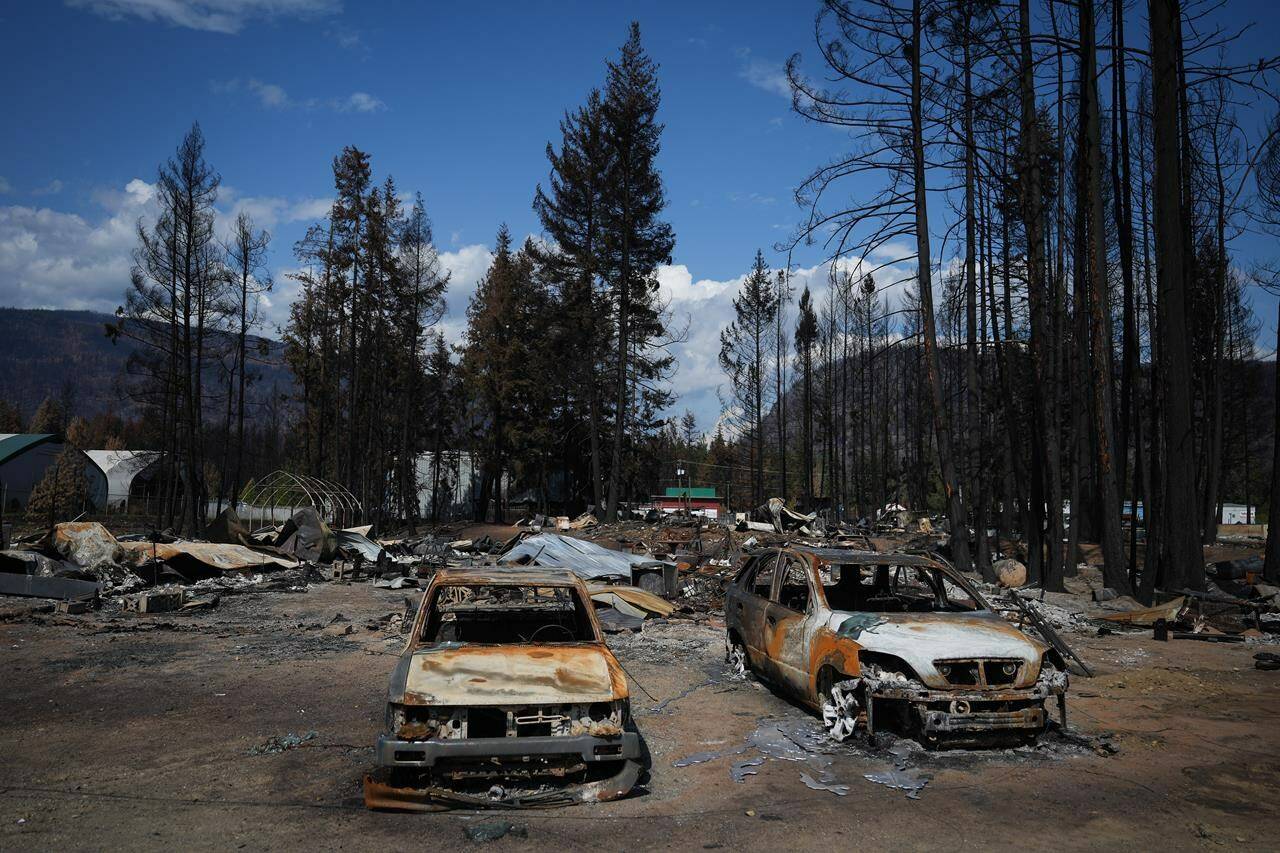All that stands of the Scotch Creek — Lee Creek firehall in the British Columbia Interior’s Shuswap region is a set of blackened stairs leading to a pile of rubble.
The ruins are a stark indication of the indiscriminate power of the Bush Creek East blaze that tore through the region about three weeks ago, with speed and ferocity that officials likened to a tornado.
It destroyed 176 properties and damaged 50 others. Some of that destruction was on display during separate tours on Wednesday for the media and residents who lost their homes in the region.
Derek Sutherland, director of the Columbia-Shuswap emergency operations centre, said the purpose of the residents’ tours was to give them “closure” so they can hopefully begin rebuilding.
“It was burning whatever was in its path, including our firehall. Some places fared better than others, of course,” he said.
But while the Bush Creek East fire is among more than 400 wildfires still burning in B.C., about half of them out of control, the escalating sense of crisis across the province is abating. It’s being replaced with worry about what comes next.
Minister of Forests Bruce Ralston said about 80 per cent of the province is under a level 4 or 5 drought, the two highest classifications. He said the province will need several inches or more of rainfall over an extended period of time to alleviate drought conditions.
Rain would also be welcome for firefighters.
Cliff Chapman with the BC Wildfire Service said the province is hopefully out of the worst of the fire season but there’s still a lot of work to be done and another ridge of high pressure in the next few weeks could mean more fire growth.
“We’ll be working extremely hard. We’ll be continuing with long shifts and 24-hour coverage to put these fires out. But we are still looking for what we refer to as a season-ending rain event and right now that is not … forecast,” he said.
The fight continues against the Bush Creek East fire, which is still burning out of control after scorching more than 430 square kilometres.
Wednesday’s media tour did not visit firefighting operations, but evidence of the ongoing battle was clear.
Across the road from a burnt-out gas station were parked four firefighting helicopters, and from Highway 1, helicopters could be seen in the air, carrying water from Shuswap Lake to the front lines.
The drive into Scotch Creek passed areas of charred and fallen trees alongside areas of lush greenery, where some properties remain untouched.
The first stop was the firehall, once painted bright red, but wrecked by the fire on Aug. 18.
About 50 metres from the hall was a parking lot that looked like a scrapyard. Blackened trees surrounded dozens of charred and rusted cars resting on their axles, with rumpled steel all that remained of a nearby building.
Sean Coubrough, deputy regional fire chief for the Columbia-Shuswap Regional District, said he was in the emergency operations centre when the fire tore through the community.
He said it was “something he had never seen before.”
“The flames certainly made it absolutely impassable. And there was no amount of resources we could have put on that that would have made any kind of difference,” he said.
He said the speed at which it came made firefighting efforts “impossible.”
“Many of our firefighters had to escape using boats.”
Further down the road to Celista, hydro workers could be seen threading power lines onto poles. Hundreds of poles have been damaged or destroyed by the fire, posing an infrastructure challenge.
Tim Conrad, public information officer for Columbia-Shuswap Regional District emergency operations, called the day “bittersweet” as residents made their way back home. After the tours, a blockade around the area was being lifted, and the first groups began re-entering about 2 p.m.
But across B.C. 3,800 people remain under evacuation order, Ma said at the briefing. Another 34,000 are under alert after thousands were ordered out of their homes across the province last month because of wildfires.
She said over the last few days evacuation alerts covering approximately 30,000 people have been rescinded allowing “families to breathe a sigh of relief as the threat level has reduced.”
Ma said a damage estimate has not been completed but they know that “hundreds” of structures have been lost across the province.
First Nations and local governments will now be able to apply for disaster relief funding to cover losses from the wildfire season that are not covered by insurance, the minister said.
“This funding can serve several purposes, including helping communities rebuild or repair essential public infrastructure like roads and bridges,” Ma said.
“It can also help local communities replace essential materials and support expenses related to inspections, appraisals, planning and design processes needed to determine recovery costs.”
READ ALSO: Drought conditions in B.C. a ‘sleeping giant of a natural disaster’
READ ALSO: Disaster relief available for communities impacted by 2023 B.C. wildfires

